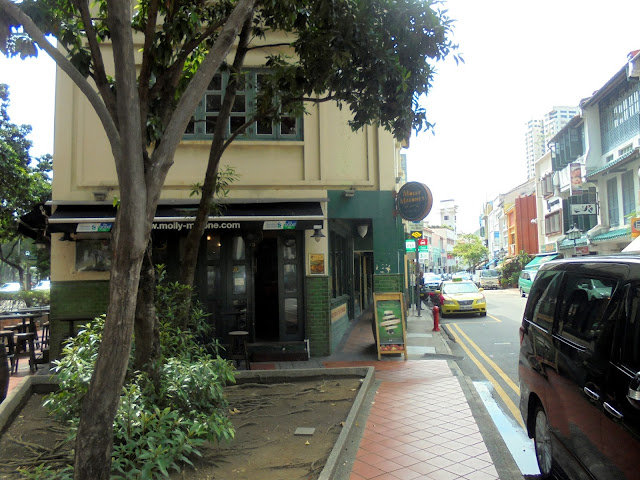In 2006, Kevin and I lived in Singapore for five months when the marketing agency I worked for temporarily reassigned me to their Singapore office. So it was a great pleasure to return, see old friends, revisit some of our favorite spots and see new ones.
Singapore is always reinventing itself, and as a stable, economic powerhouse, it is envied by other countries in Southeast Asia. Politically, it effectively operates under one-party rule (the party of the founding father of Singapore, Lee Kuan Yew, who died at age 91 last year.) Lee Kuan Yew led Singapore from its independence in 1965 and transformed it into the modern city-state it is today. His son succeeded him.
Singapore remains a beautiful, clean, city-state with virtually no violent crime, good public services, and an attractive place to visit.
Lying 88 miles from the equator, Singapore is also hot and humid, but air-conditioning and the lush vegetation makes it much more comfortable. However, I had forgotten what it was like to get out of a cab and have my glasses fog up from the heat!
The best thing about our Singapore visit was getting re-acquainted with friends. Kevin reconnected with T.T., his friend, the porcelain collector, who first introduced Kevin to Asian porcelain. Becoming friends with T.T. and learning about porcelain was the highlight of Kevin's stay in Singapore in 2006, and it has given him a lifelong interest. (Unfortunately, we do not have a pocketbook for extensive porcelain-collecting, but Kevin has acquired a few pieces and a lot of knowledge that has enriched his life.) T.T. gave Kevin another gift of porcelain figurines on this visit, which I know he will treasure.
For me, the highlight of this visit to Singapore was seeing my friend and colleague, Violet, once again. Violet and I worked together in 2006. Violet treated Kevin and me to a wonderful Indonesian lunch:
Kevin wanted to say goodbye to T.T., so he left us after lunch, and I accompanied Violet to her lovely home in the suburbs, where I met her sister Margaret. Talk about hospitality! Violet and her sister gave me a gift of a carving of the Singapore skyline, a handcrafted handbag, and some hand-embroidered emblems that Margaret had made:
Singapore continues to grow and change. A taxi driver jokingly pointed to a construction crane that towered over the nearby buildings and said, "That's Singapore's national bird."
New to Singapore, since we lived there, is Gardens by the Bay, a nature park of 250 acres, built on reclaimed land. When I observed photos of the gardens and their supertrees before this visit, I wasn't too impressed. But when I actually visited there, I found the gardens and the supertrees delightful! The gardens radiate beauty day or night.
We particularly liked the evening light show. I've seen sound-and-light shows at many locations, but this one was especially pleasing. We watched from the Supertree Grove as the lights pulsed to show tunes like "Memory," "I Dreamed a Dream," "All that Jazz," and others. I think it may have been the best free show I ever saw; the dazzling display went on for about 15 minutes.
The long curving line in the photos below is a walkway. It made some attractive abstract photos.
 |
| The Gardens by the Bay light show must not be missed! |
No, it wasn't quite an experience in nature, although the supertrees are covered with plants, but it was magical. I guess I'm still a kid at heart. I love fireworks and light displays!
You can search for a video of the show that another tourist posted on YouTube, alhough nothing compares to actually being under those supertrees, leaning back looking up, as the lights dance above you. (Be sure to click the full-screen icon to view it.)
Gardens by the Bay also features an odd baby sculpture that seems to float over the hedges.The sculpture is called "Planet." It's by UK sculptor Marc Quinn and was modeled after his own infant son. I wish my night photo of it had turned out, when it really looks surreal. It's huge! It's 10 meters long (almost 33 feet).
It's not universally loved. One critic said of it, "I'm delighted that Quinn is soppy about his son, but see no reason why he should share this on such a colossal scale. Art that flaunts its content in an immediately readable way risks vacuity. Shouldn't there be some ambiguity, even profundity, in art?"
We were sorry that we didn't get to some of our favorite places in Singapore, including MacRitchie Reservoir, which includes a rain forest park with monitor lizards and monkeys--right in the middle of Singapore. Or Pulau Ubin, on island off the coast that is now mostly a nature reserve. I understand it still has the small village (kampung) where people live much as they used to years ago. But time, sadly, did not allow us the opportunity to visit again. Having heard that our renter in Seattle was leaving, we cut the last part of our journey short.
However, it was wonderful to see our friends again and to walk the streets of this vibrant city. Singapore has so much to offer travelers, especially those who seek out its hidden treasures.









































